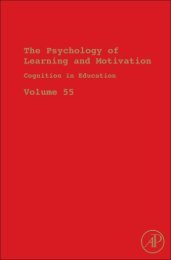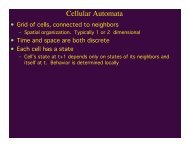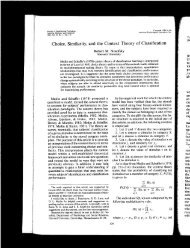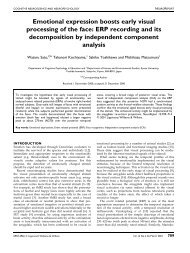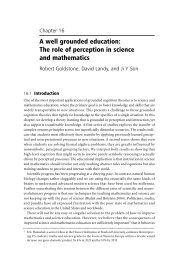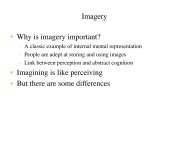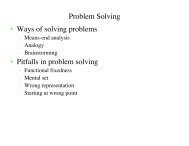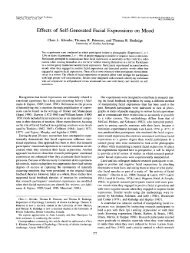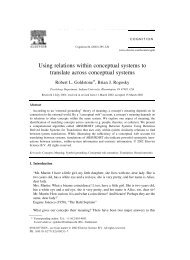Early Perceptual Learning - Percepts and Concepts Laboratory ...
Early Perceptual Learning - Percepts and Concepts Laboratory ...
Early Perceptual Learning - Percepts and Concepts Laboratory ...
Create successful ePaper yourself
Turn your PDF publications into a flip-book with our unique Google optimized e-Paper software.
Infancy, 16(1), 45–51, 2011Copyright Ó International Society on Infant Studies (ISIS)ISSN: 1525-0008 print / 1532-7078 onlineDOI: 10.1111/j.1532-7078.2010.00054.x<strong>Early</strong> <strong>Perceptual</strong> <strong>Learning</strong>Robert L. GoldstoneDepartment of Psychological <strong>and</strong> Brain SciencesIndiana UniversityJi Y. SonDepartment of PsychologyCalifornia State UniversityLisa ByrgeDepartment of Psychological <strong>and</strong> Brain SciencesIndiana UniversityBhatt <strong>and</strong> Quinn (2011) present a compelling case that human learning isearly in two very different, but interacting, senses. <strong>Learning</strong> is developmentallyearly in that even infants show strikingly robust adaptation to the structurespresent in their world. <strong>Learning</strong> is also early in an information processingsense because infants’ adapt their perceptual encodings <strong>and</strong> organizations atan early stage of neural processing. Both senses of ‘‘early’’ speak to the importanceof learning because they imply that learners are adapting their representationsof their environment in a way that affects all ‘‘down-stream’’processing. Developmentally speaking, the learning that an infant enactsserves as the groundwork for all subsequent learning. In terms of informationprocessing, adapting early-stage sensory <strong>and</strong> perceptual processes in turnaffects all subsequent cognitive processes. There is evidence from neurosciencethat interactions with an environment do cause early changes to primaryCorrespondence should be sent to Robert L. Goldstone, Department of Psychological <strong>and</strong>Brain Sciences, Indiana University, 1101 E. 10th St., Bloomington, IN 47405. E-mail: rgoldsto@indiana.edu
46 GOLDSTONE, SON, & BYRGEsensory cortices (Goldstone, 1998; Vogels, 2010). One might generallysuppose that it is advisable to be conservative in making such environmentdrivencortical changes, given the ripples of influence caused by early learningin both senses. Manipulating grounding representations is a risky proposition.However, the evidence indicates that systems that need to respond effectivelyto their environment need to engage in both kinds of learning.This very fact is worth dwelling upon. One might have thought thatdevelopmentally early perceptual learning would occur rarely because evolutionshould have already tuned our perceptual systems to be sensitive to themost important elements of the world in which we live (Olshausen & Field,1996). Having an adaptive perceptual system is advantageous when theworld is variable. However, at least at a first pass, is not the world fairly stable?We are all exposed to the same wavelengths of light thanks to the sun’sspectral class. The gravitational constant is, here on earth, constant. Nonetheless,people do face different environments. To a large extent, a person’senvironment consists of animals, people, <strong>and</strong> things made by people. All ofthese things show local <strong>and</strong> regional variation, due to evolution <strong>and</strong> hum<strong>and</strong>esign. If we need to be able to identify a particular plant, animal, person,or artifact, then this skill needs to be learnable. Furthermore, if we want theskill to be efficient, then it should become perceptual rather than strategic orreflective.The field of biology is being transformed by an appreciation that twotime courses of organismic change, evolutionary <strong>and</strong> developmental, interactwith each other in important ways (Carroll, 2005). This Evo-Devo movementhas discovered that a small set of regulatory genes shared by manydifferent life forms have a large influence on the eventual form <strong>and</strong> functionof organisms by modulating their development. It is tempting to include athird time course, that of processing of individual environmental inputs, tocreate an Evo-Devo-Info triumvirate of interacting <strong>and</strong> adaptive processes.Bhatt <strong>and</strong> Quinn (2011) provide some early details on what some of theseinteractions look like. One example of such an interaction is that evolutionary-scalelearning can drive learning across the lifetime, which, in turn,drives adaptation of the information processing of individual events. Bhatt<strong>and</strong> Quinn describe Spelke’s (1990) evidence that infants appear predisposedto treat parts of a display that move together as belonging to the sameobject. Once spatially separated parts of a display are joined together in thesame object because of their common motion, the infant can learn aboutother systematic object properties, such as edges, smoothly varying contours,<strong>and</strong> uniform coloration. These secondary properties, once detected,undergo a learning process whereby they become processed by relativelyearly, in the sense of information processing stages, neural areas (Fahle &Poggio, 2002). In this manner, perceptual constraints that have been
EARLY PERCEPTUAL LEARNING 47acquired on an evolutionary time scale lead to constraints that are acquiredover an organism’s lifetime, which constrain how individual events are processed.By this view, evolved perceptual processes are not opposed to learningprocesses. There is no ‘‘innate VERSUS learned’’ territory conflict. Wehave evolved so that experience with a richly <strong>and</strong> diversely structured worldallows us to devise many of the constraints that we subsequently use to efficientlylearn more from our world (Goldstone & L<strong>and</strong>y, 2010).UNITIZATION, SELECTION, AND DIFFERENTIATIONBhatt <strong>and</strong> Quinn (2011) describe five categories of learning experiences thatlead infants to create new perceptual organizations. They propose twomechanisms of perceptual learning that underpin these five categories. Thefirst is selective attention—learning to attend to relevant information <strong>and</strong>disregard irrelevant information. The second is unitization—learning tocombine together elements to create larger, more complex configurationsthat come to be processed as a single entity. These two mechanisms are insome ways converses of each other. The first picks out <strong>and</strong> differentiallyweights elements from a larger whole. The second fuses elements together tocreate a whole. However, as Bhatt <strong>and</strong> Quinn observe, these two mechanismsare flip sides of the same coin—they create perceptual units of organizationthat effectively capture presented structure. When there is an elementthat occurs across several varying contexts <strong>and</strong> it is differentially diagnosticfor an important task, then the element tends to be selectively attended(Needham & Baillargeon, 1998; Quinn & Bhatt, 2005b). When an elementtends to co-occur with other elements, <strong>and</strong> together they are diagnostic, thenthe elements are joined together into a single unit. Many environmentsrequire both selective attention to parts <strong>and</strong> unitization, such as wheninfants learn to break a sound stream into separate speech units at the sametime that they learn to group together the sounds from a single unit (Saffran,Aslin, & Newport, 1996). Sound elements are inferred to come from a singleunit if there are high conditional probabilities between the elements, <strong>and</strong> tocome from different units if the conditional probabilities are low.To these complementary mechanisms of perceptual learning, we proposeadding a third mechanism: attribute differentiation. To underst<strong>and</strong> theimportance of this third mechanism, it helps to reflect on the requirementsof selective attention. Selective attention critically depends on perceptualattributes that have already been psychologically isolated. That is, it is onlypossible for an observer to attend to the brightness of a shape <strong>and</strong> ignore itssize if the attribute of brightness has been isolated <strong>and</strong> separated from size.One st<strong>and</strong>ard conception for how attributes are isolated is for there to be a
EARLY PERCEPTUAL LEARNING 49computational models that explain how attribute differentiation mechanismsmight operate. Competitive learning neural networks differentiateinputs into categories by specializing detectors to respond to classes ofinputs. R<strong>and</strong>om detectors that are slightly more similar to an input thanother detectors will learn to adapt themselves toward the input <strong>and</strong> willinhibit other detectors from doing so (Rumelhart & Zipser, 1985). A modelthat extended this mechanism to sorting object parts into detectors, whenpresented with an original set of training objects, was able to discover partbasedbuilding blocks that could be recombined to recreate the originaltraining objects (Goldstone, 2003). Other learning systems show similarfunctional behavior by using Expectation Maxmization (Ghahramani, 1995)or Bayesian (Austerweil & Griffiths, 2009) methods. In short, recentadvances in machine learning provide existence proofs of mechanisms fordimension differentiation. Water <strong>and</strong> wine can be separately extracted if onehas not only a single mixed sample, but several samples with different proportionsof water <strong>and</strong> wine.Although there are working computational models <strong>and</strong> at least suggestiveevidence that people can come to be able to differentiate originally fusedattributes (Hockema, Blair, & Goldstone, 2005), we concur with Bhatt <strong>and</strong>Quinn’s (2011) decision to stress selective attention <strong>and</strong> unitization. The evidencefor attribute differentiation is controversial (Op de Beeck, Wagemans,& Vogels, 2003) <strong>and</strong> not as plentiful as the evidence for the other two mechanisms.However, our reason to discuss it here is because it seems like afruitful avenue for future developmental research. There is reason to believethat attribute differentiation may play a particularly important role forinfants. Namely, infants are in the business of creating the perceptual buildingblocks that will serve them a lifetime. Whereas selective attention canincrease or decrease the importance given to existing building blocks, onlyattribute differentiation can create the building blocks in the first place.Whereas adults may be biased to interpret their world in terms of perceptualrepresentations that they have already built, infants may be relatively predisposedto create new dimension <strong>and</strong> part representations. If so, this would bean interesting partial 1 exception to Bhatt <strong>and</strong> Quinn’s expectation that perceptuallearning is qualitatively similar across ages. Future work may revealthat infants, when exposed to a world of objects composed out of underlyingparts or dimensions, are more likely to discover these elements than areadults, if general learning efficiency is controlled.1 The exception would only be partial because Bhatt <strong>and</strong> Quinn are mostly concerned withage differences within infancy, <strong>and</strong> because we are only arguing for the relative intransigence,not impossibility, of dimension differentiation in adults.
50 GOLDSTONE, SON, & BYRGEACKNOWLEDGMENTSThe authors wish to express thanks to Linda Smith for helpful suggestionson this work. This work was funded by National Science FoundationREESE grant 0910218. More information about the laboratory can befound at http://cognitrn.psych.indiana.edu.REFERENCESAusterweil, J., & Griffiths, T. L. (2009). Analyzing human feature learning as nonparametricBayesian inference. Advances in Neural Information Processing Systems, 21, 386–492.Bhatt, R. S., & Quinn, P. C. (2011). How does learning impact development in infancy? Thecase of perceptual organization. Infancy, 16, 2–38.Carroll, S. B. (2005). Endless forms most beautiful: The new science of Evo Devo <strong>and</strong> the makingof the animal kingdom. New York: Norton.Fahle, M., & Poggio, T. (2002). <strong>Perceptual</strong> learning. Cambridge, MA: MIT Press.Garner, W. R. (1976). Interaction of stimulus dimensions in concept <strong>and</strong> choice processes.Cognitive Psychology, 8, 98–123.Ghahramani, Z. (1995). Factorial learning <strong>and</strong> the EM algorithm. In G. Tesauro,D. S. Touretzky, & T. K. Leen (Eds.), Advances in Neural Information Processing Systems 7(pp. 617–624). Cambridge, MA: MIT Press.Goldstone, R. L. (1998). <strong>Perceptual</strong> learning. Annual Review of Psychology, 49, 585–612.Goldstone, R. L. (2003). <strong>Learning</strong> to perceive while perceiving to learn. In R. Kimchi,M. Behrmann, & C. Olson (Eds.), <strong>Perceptual</strong> organization in vision: Behavioral <strong>and</strong> neural perspectives(pp. 233–278). Mahwah, NJ: Lawrence Erlbaum Associates.Goldstone, R. L., & L<strong>and</strong>y, D. H. (2010). Domain-creating constraints. Cognitive Science, 34,1357–1377.Goldstone, R. L, & Steyvers, M. (2001). The sensitization <strong>and</strong> differentiation of dimensions duringcategory learning. Journal of Experimental Psychology: General, 130, 116–139.Hockema, S. A., Blair, M. R., & Goldstone, R. L. (2005). Differentiation for novel dimensions.Proceedings of the twenty-seventh annual conference of the cognitive science society (pp. 953–958). Hillsdale, NJ: Lawrence Erlbaum Associates.Kemler, D. G., & Smith, L. B. (1978). Is there a developmental trend from integrality to separabilityin perception? Journal of Experimental Child Psychology, 26, 498–507.Needham, A., & Baillargeon, R. (1998). Effects of prior experience on 4.5-month-old infants’object segregation. Infant Behavior <strong>and</strong> Development, 21, 1–24.Olshausen, B. A., & Field, D. J. (1996). Emergence of simple-cell receptive field properties bylearning a sparse code for natural images. Nature, 381, 607–609.Op de Beeck, H., Wagemans, J., & Vogels, R. (2003). The effect of category learning on the representationof shape: Dimensions can be biased but not differentiated. Journal of ExperimentalPsychology: General, 132, 491–511.Quinn, P. C., & Bhatt, R. S. (2005a). Good continuation affects discrimination of visual patterninformation in young infants. Perception & Psychophysics, 67, 1171–1176.Quinn, P. C., & Bhatt, R. S. (2005b). <strong>Learning</strong> perceptual organization in infancy. PsychologicalScience, 16, 515–519.
EARLY PERCEPTUAL LEARNING 51Quinn, P. C., & Schyns, P. G. (2003). What goes up may come down: <strong>Perceptual</strong> process <strong>and</strong>knowledge access in the organization of complex visual patterns by young infants. CognitiveScience, 27, 923–935.Quinn, P. C., Schyns, P. G., & Goldstone, R. L. (2006). The interplay between perceptual organization<strong>and</strong> categorization in the representation of complex visual patterns by young infants.Journal of Experimental Child Psychology, 95, 117–127.Rumelhart, D. E., & Zipser, D. (1985). Feature discovery by competitive learning. CognitiveScience, 9, 75–112.Saffran, J. R., Aslin, R. N., & Newport, E. L. (1996). Statistical learning by 8-month-oldinfants. Science, 274, 1926–1928.Smith, L. B. (1989). From global similarity to kinds of similarity: The construction of dimensionsin development. In S. Vosniadou & A. Ortony (Eds.), Similarity <strong>and</strong> analogical reasoning(pp. 146–178). Cambridge, UK: Cambridge University Press.Smith, L. B., Gasser, M., & S<strong>and</strong>hofer, C. (1997). <strong>Learning</strong> to talk about the propertiesof objects: A network model of the development of dimensions. In R. L. Goldstone,P. G. Schyns, & D. L. Medin (Eds.), The psychology of learning <strong>and</strong> motivation, Vol. 36 (pp.219–255). San Diego, CA: Academic Press.Smith, L. B., & Kemler, D. G. (1978). Levels of experienced dimensionality in children <strong>and</strong>adults. Cognitive Psychology, 10, 502–532.Spelke, E. S. (1990). Principles of object perception. Cognitive Science, 14, 29–56.Vogels, R. (2010). Mechanisms of visual perceptual learning in macaque visual cortex. Topics inCognitive Science, 2, 239–250.



